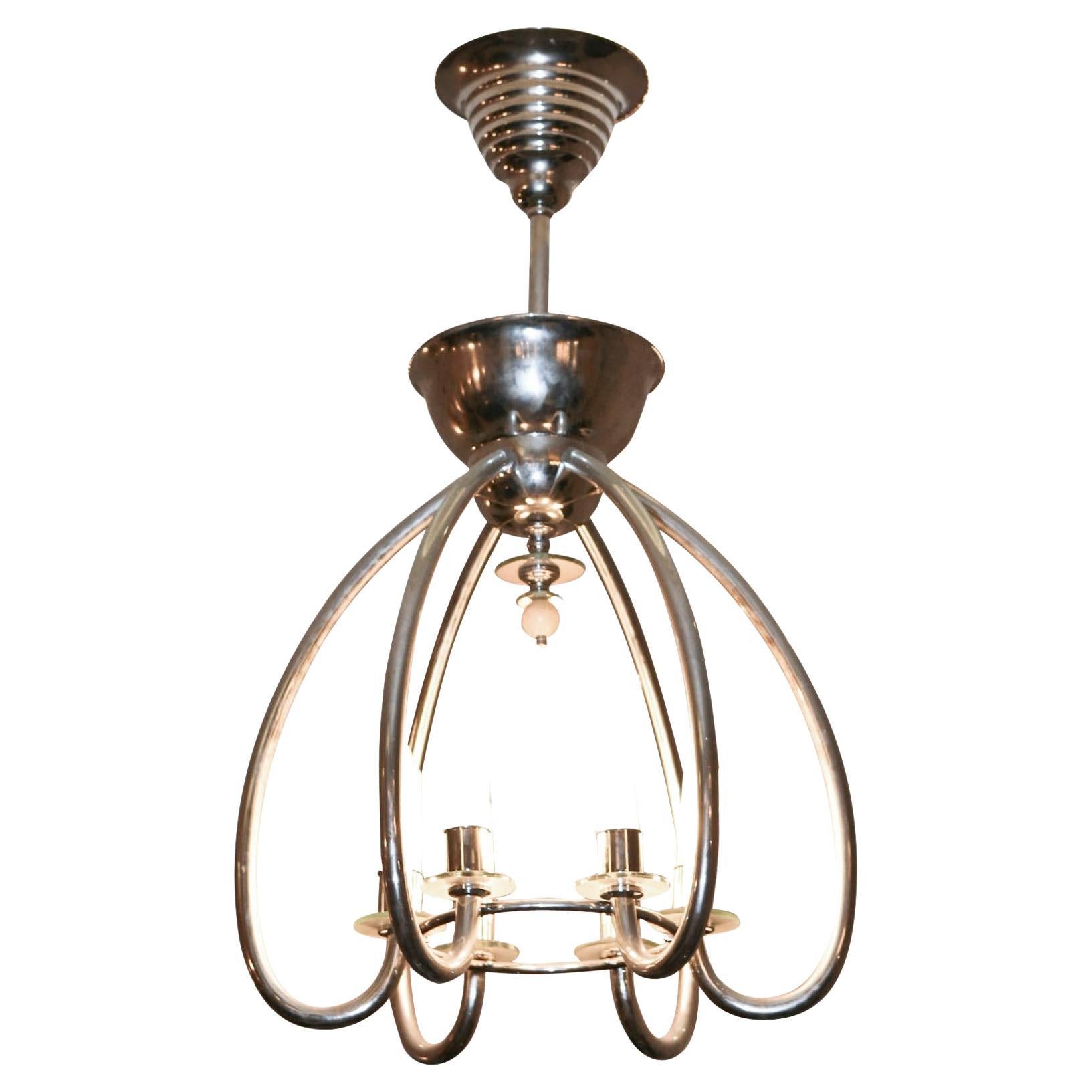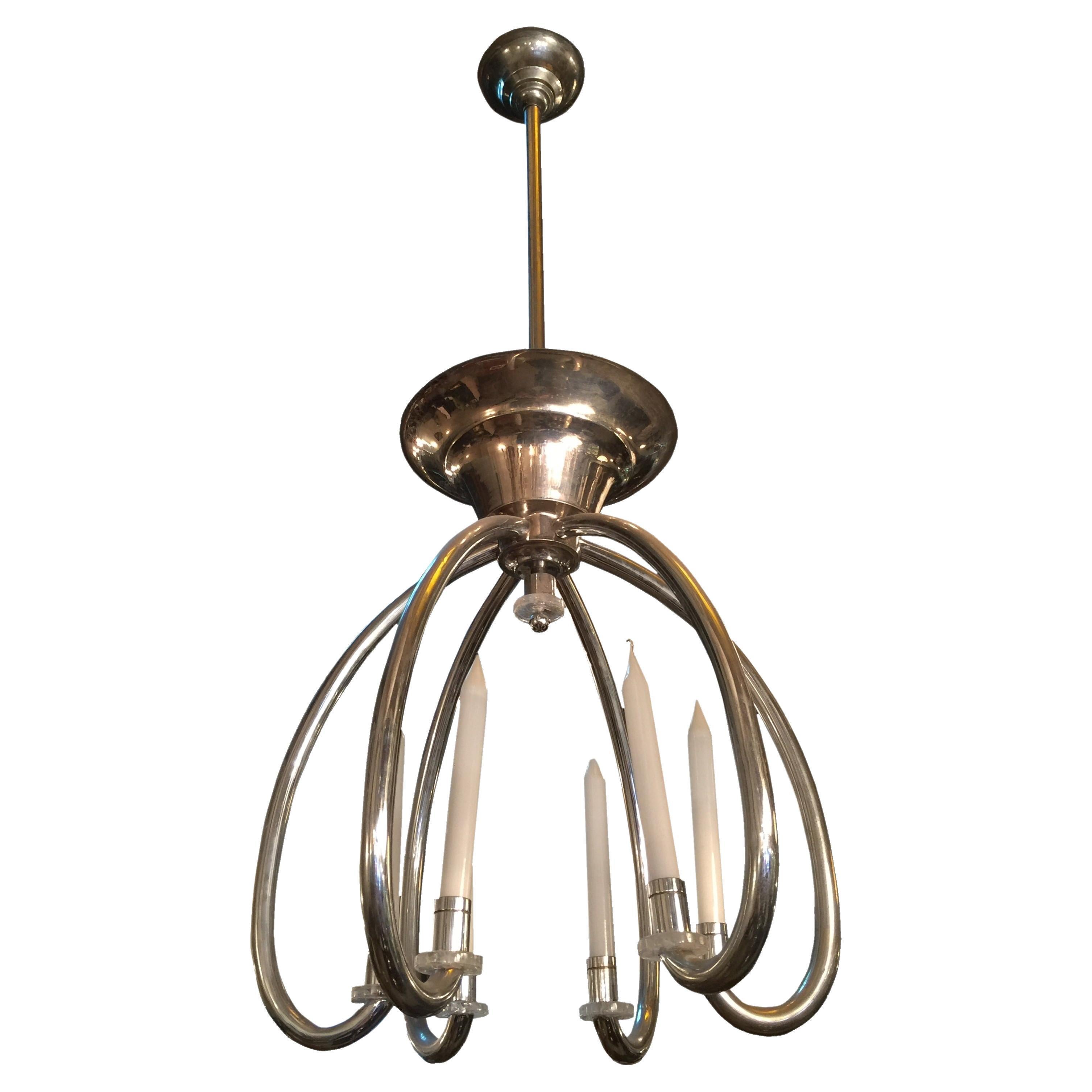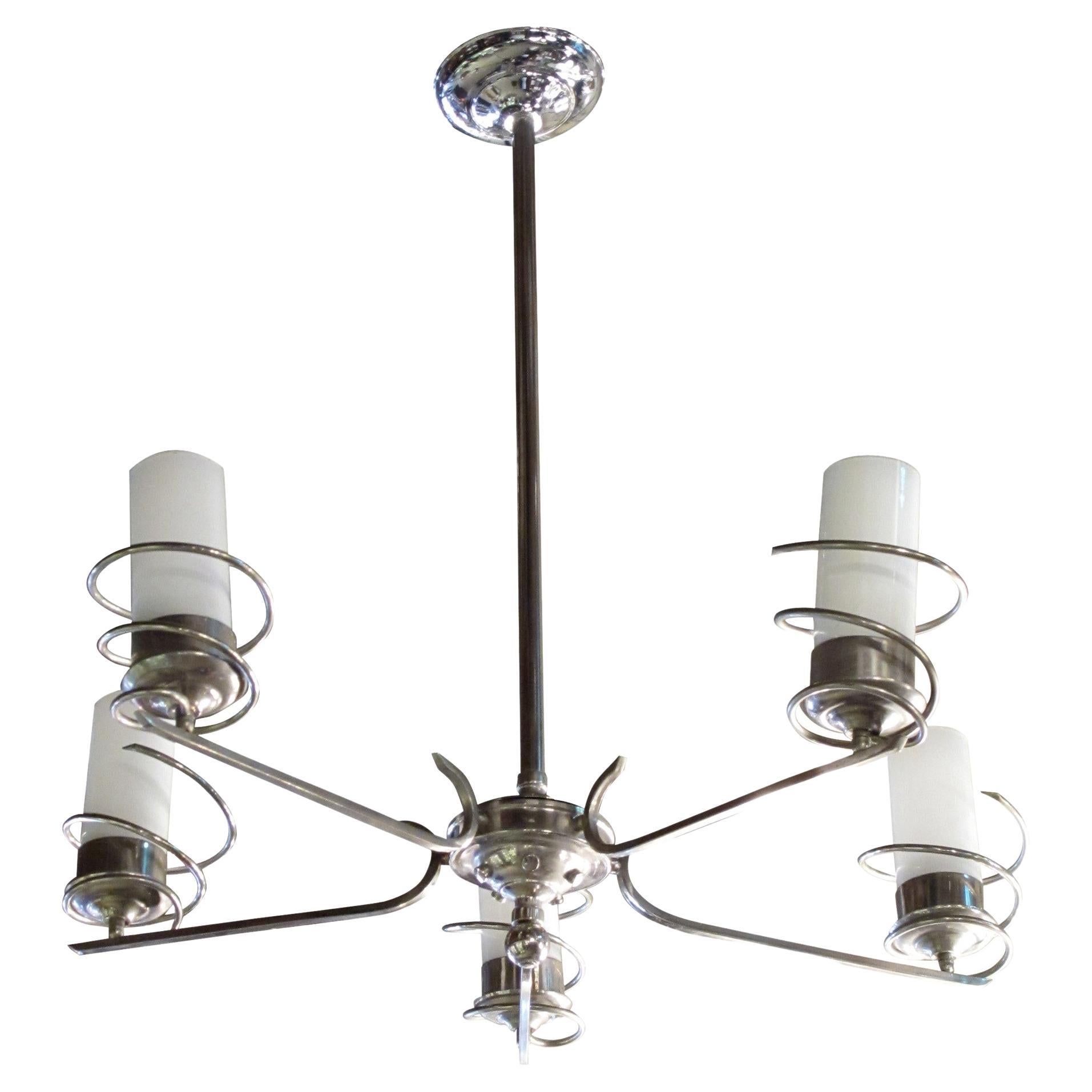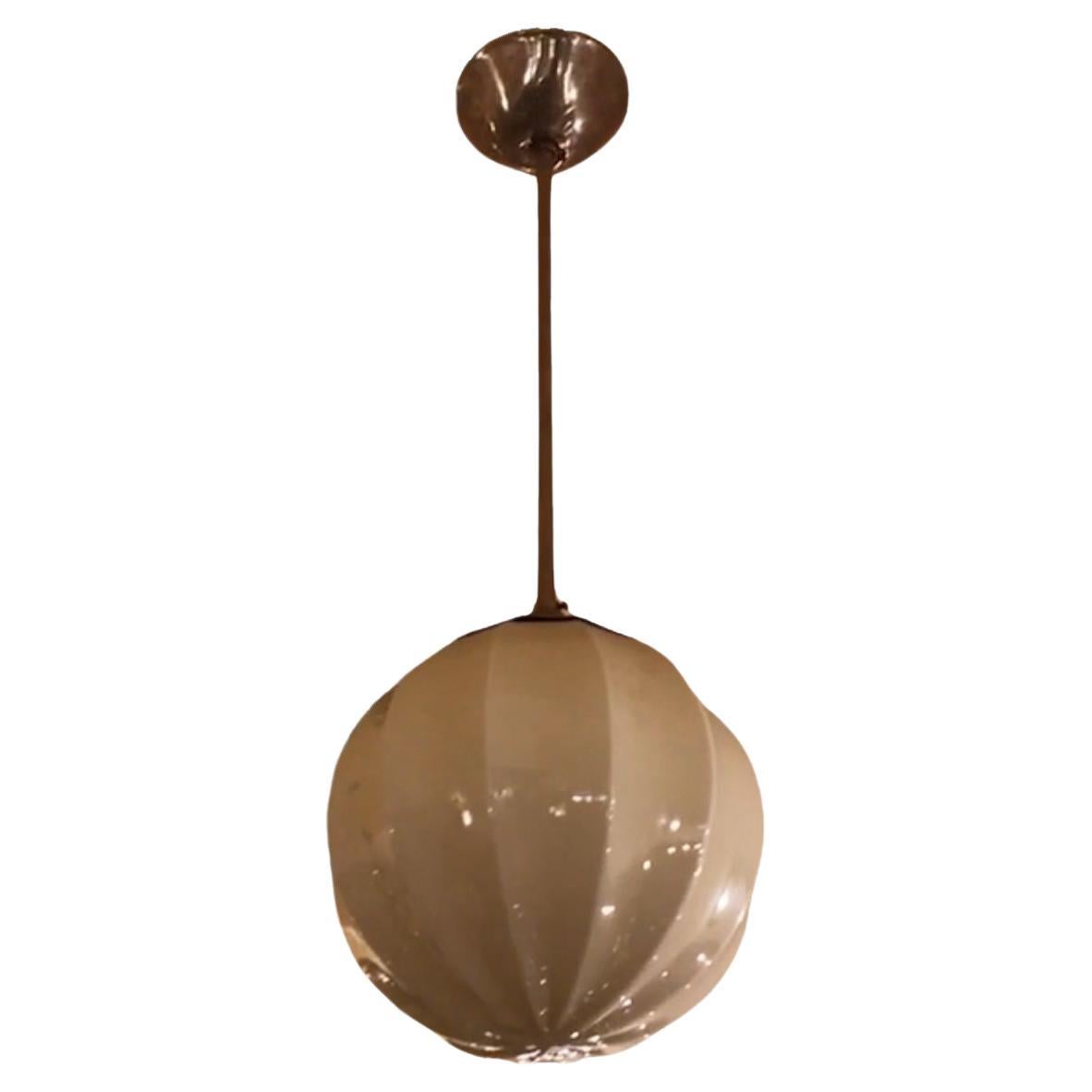Items Similar to Hanging Lamp German in Opaline, Chromed Bronze, 1920, Style Art. Deco
Video Loading
Want more images or videos?
Request additional images or videos from the seller
1 of 14
Hanging Lamp German in Opaline, Chromed Bronze, 1920, Style Art. Deco
About the Item
Amaizing hanging lamp
Material: Chromed bronze, opaline glass, glass
Style: Art Deco
Country:German
If you are looking for sconces to match your ceiling lighting, we have what you need.
To take care of your property and the lives of our customers, the new wiring has been done.
If you want to live in the golden years, this is the lighting that your project needs.
We have specialized in the sale of Art Deco and Art Nouveau and Vintage styles since 1982.If you have any questions we are at your disposal.
Pushing the button that reads 'View All From Seller'. And you can see more objects to the style for sale.
Why are there so many antiques in Argentina?
In the 1880 – 1940 there was a grate wave of immigration encouraged by the periods of war that were taking place.
1st World War took place between 1914 and 1918
2nd World War took place between 1939 and 1945
The immigrants options were New York or Buenos Aires. Tickets were cheap and in Buenos Aires they were welcomed with open arms, as it was a country where everything was still to be done.
Argentina was the country of new opportunities, labour was needed and religious freedom was assured, in many cases the of the family travel first until they were settled and then the rest of the family members join them.
In the immigrant museum “Ellis Island Immigrant Building” in New York you can se the promotional posters of the boats that would take them to a new life.
Between the years 1895 and 1896, Argentina had the highest DGP (gross domestic product) per capita in the world according to the Maddison Historical Statistics index, this situation arose due to the large amount of food being exported to European countries, which were at war.
The Argentinean ships left the port of Buenos Aires with food, but they returned with furniture, clothes and construction elements, (it´s common to see this the old buildings of the historic neighbourhood of San Telmo, the beams with the inscription “Made in England)”, as well as many markets that were built in Buenos Aires, such us the San Telmo Market, whose structure was brought by ship and afterwards assembled in 900 Defensa Street.
With the great influence of European immigrants living in the country, the children of the upper classes travelled to study in France, resulting in the inauguration of “La Maison Argentinienne”, on 27th of June 1928, in the international city of Paris, which hosted many Argentinians that were studying in Frace.
It´s the fourth house to be built after France, Canada and Belgium, being the first Spanish-speaking one. Still in place today (17 Bd Jourdan, 75014, Paris, France). Many of the children of these wealthy families who attended international art exhibitions, museums and art courses abroad, took a keen interest in the European style. This is why Buenos Aires was at the time referred as “The Paris of South America”.
Between the years 1890 and 1920 more than a hundred Palaces were built on Alvear Avenue the most exclusive avenue in Buenos Aires. Today some of these palaces have been transformed into museums, hotels and embassies.
In the year 1936, the Kavanagh building was inaugurated, it was the tallest reinforced concrete building in South America.
During 1994 the American Society of Civil Engineers distinguished it as an “international engineering milestone”, and it´s now considered a World Heritage of Modern Architecture.
At the time was common to hire foreign architects such as Le Corbusier, who visited Buenos Aires/Argentina in 1929 and in 1948 he drew up the blueprints for a house built in La Plata City (which was declared a World Heritage Site).
In 1947, the Hungarian architect Marcelo Breuer designed “Parador Ariston” in the seaside city of Mar del Plata. After an Argentinean student at Harvard University convinced him to come to Argentina. He worked on an urban development project in the Casa Amarilla, area of La Boca.
The Ukrainian architect, Vladimiro Acosta, arrives in Argentina in 1928 and worked as an architect until que moved to Brazil.
Antonio Bonet, a Spanish architect who worked with Le Corbusier in Paris, arrives in Argentina in 1937, where he carried out several architectural works and in 1938 designs the well-known BFK chair.
Andres Kálnay, of Hungarian origin, made around 120 architectural masterpieces, among which the former Munich brewery stands out, he even made the furniture’s design.
The German architect, Walter Gropius, director of the Bauhaus, lived in Argentina, where he wrote articles for “Sur” magazine and founded in Buenos Aires, an architectural firm with Franz Möller, who was also an architect, where he built two houses.
At the same time several famous designers decided to immigrate to Argentina, among them we can find the well-known French designer, Jean-Michel Frank, who arrived in the country in 1940 and also worked for the Rockefeller family.
Special pieces were made, which were sold exclusively in the country, such as the well-known German company “WMF”, who sold their products by catalogue, which were chosen by the ladies of high society in the list of wedding gifts, as well as the pieces designed by Christofle.
The Swiss sculptor Alberto Giacometti, made special pieces for Argentinean mansions.
In 1904 the first Jansen branch outside Paris was established in Buenos Aires, as the Argentinean clientele demanded a large amount of furniture, from the end of the 19th century to the mid-20th century.
In 1970, the brand Rigolleau Argentina made pieces authorised by Lalique.
The brands Maple and Thompson also set up shop in the country.
The French plastic artist, Marcel Duchamp moved to Argentina in 1918-1919.
Glass signed Gallé, Charder, Leverre, Schneider, Muller and other French firms. They were bought in flower shops and were given to ladies with beautiful floral arrangements.
Some furniture manufacturers travelled to international fairs and bough the patterns to produce the furniture in Argentina, such as the furniture firm Englander and Bonta, who bought the patterns ins Italy.
It is worth mentioning that in Argentina we have the largest community of Italians outside of Italy, as it is estimated that 70 percent of the inhabitants have at least one Italian descendant, followed by Spanish immigrants.
The most Important furniture stores in Argentina:
Comte is founded in 1934 (under the direct management of Jean Michel Frank in 1940).
Nordiska (Swedish company established in 1934).
Churba in 1960, a company that brought foreign designers to present their furniture in the country:
Denmark: (Arne Jacobsen, Finn Juhl, Bender Madsen, Ejner Larsen, Poul Kjaerholm, Hans Wegner)
Sweden: (Hans Agne Jakobsson, Gustavsberg)
United States: (Herman Miller)
Finland: (Lisa Johansson, Folke Arstrom, Tapio Wirkkala, Alvar Aalto, Timo Sarpaneva)
Swedish Factory: (Orrefors)
Italy: (Littala, Vico Magistretti, Emma Gismondi, Gae Aulenti, Angelo Mangiarotti, Elio Martinelli, Gianna Celada, Angelo Mangiarotti, Mario Bellini, Carlo Scarpa)
Finland: (Olivia Toikka)
Plata Lappas (Lappas Silver): a goldsmith shop founded in 1887 in Argentina by Alcibiades Lappas of Greek origin.
In 2019, in Argentina took place “the Art Deco world congress”, in which we participated as hosts invited by Geo Darder, founder of the Copperbridge – Foundation, in which prominent people from all over the world attended to learn about Art Deco in Argentina.
Argentina currently has more than 100 Art Deco buildings and another 90 Art Nouveau buildings throughout the city of Buenos Aires.
Argentina is a country that has not been involved in many wars, which is why it has been a refuge for works of art and antiques from different periods of time, unlike European countries. That is way many collectors, museums and antique dealers from all over the world visit it, you should not miss the opportunity to visit this great country.
Laura Guevara Kjuder, architect.
- Dimensions:Height: 38.19 in (97 cm)Diameter: 16.54 in (42 cm)
- Power Source:Hardwired
- Voltage:220-240v
- Lampshade:Included
- Style:Art Deco (Of the Period)
- Materials and Techniques:
- Place of Origin:
- Period:
- Date of Manufacture:1920
- Condition:Rewired. Wear consistent with age and use.
- Seller Location:Ciudad Autónoma Buenos Aires, AR
- Reference Number:
About the Seller
5.0
Vetted Seller
These experienced sellers undergo a comprehensive evaluation by our team of in-house experts.
Established in 1982
1stDibs seller since 2022
21 sales on 1stDibs
Typical response time: <1 hour
- ShippingRetrieving quote...Ships From: Ciudad Autónoma Buenos Aires, Argentina
- Return PolicyThis item cannot be returned.
More From This SellerView All
- Big Hanging Lamp German in Opaline, Chromed Bronze, 1920, Style Art. DecoLocated in Ciudad Autónoma Buenos Aires, CAmaizing hanging lamp Material: Chromed bronze, opaline glass, glass Style: Art Deco Country:German If you are looking for sconces to match your ceiling lighting, we have what you n...Category
Vintage 1920s German Art Deco Chandeliers and Pendants
MaterialsChrome
- Monumental German Chandelier in Opaline, Chromed Bronze, 1920, Style Art. DecoLocated in Ciudad Autónoma Buenos Aires, CAmaizing hanging lamp Material: Chromed bronze, opaline glass, glass Style: Art Deco Country:German To take care of your property and the lives of our customers, the new wiring has ...Category
Vintage 1920s German Art Deco Chandeliers and Pendants
MaterialsChrome
- Big German Chandelier in Opaline, Chromed Bronze, 1920, Style Art DecoLocated in Ciudad Autónoma Buenos Aires, CAmaizing hanging lamp. Material: Chromed bronze, opaline glass Style: Art Deco Country:German To take care of your property and the lives of our customers, the new wiring has been d...Category
Vintage 1920s German Art Deco Chandeliers and Pendants
MaterialsChrome
- Art Deco Ceiling Lamp, German, 1920, Style: Art Deco in chrome and OpalineLocated in Ciudad Autónoma Buenos Aires, CHanging lamp Material: Chromed , opaline glass Style: Art Deco Country: German To take care of your property and the lives of our customers, the new wiring has been done. If you wan...Category
Vintage 1920s German Art Deco Chandeliers and Pendants
MaterialsChrome
- Chandelier in Opaline Glass and Chromed Bronze, Style: Art Deco, German, 1920Located in Ciudad Autónoma Buenos Aires, CHanging lamp Material: Chromed bronze, opaline glass Style: Art Deco Country: German If you are looking for an chandelier to match the set of sconces we have what you need. To take ...Category
Vintage 1920s German Art Deco Chandeliers and Pendants
MaterialsChrome
- Art Deco Hanging Lamp in opaline and Bronze, 1930, GermanLocated in Ciudad Autónoma Buenos Aires, CHanging lamp. Style: Art Deco To take care of your property and the lives of our customers, the new wiring has been done. We have specialized in the sale of Art Deco and Art Nouveau ...Category
Vintage 1930s French Art Deco Chandeliers and Pendants
MaterialsBronze
You May Also Like
- Art Deco Chandelier hanging lamp bronze lamp alabaster bowl, 1920sLocated in Saarburg, RPArt Deco chandeliers bronze lamp alabaster bowl, 1920s This original pendant lamp impresses with its design. The lamp provides a very pleasant light. This ceiling lamp is an absolut...Category
Early 20th Century French Art Deco Chandeliers and Pendants
MaterialsAlabaster, Brass, Bronze
- Art Deco Chandelier hanging lamp bronze lamp alabaster bowl, 1920sLocated in Saarburg, RPArt Deco chandeliers bronze lamp alabaster bowl, 1920s This original pendant lamp impresses with its design. The lamp provides a very pleasant light. This ceiling lamp is an absolut...Category
Early 20th Century French Art Deco Chandeliers and Pendants
MaterialsAlabaster, Bronze
- Bronze Art Deco Hanging LampLocated in Banská Štiavnica, SKBronze Art Deco hanging lamp in very good original condition.Category
Vintage 1930s Slovak Art Deco Chandeliers and Pendants
MaterialsBronze
- Art Deco Marbled Cream Opaline & Bronze Pendant with Tassel, Germany 1920s 1930sLocated in NUEMBRECHT, NRWThis unusual large pendant was designed and manufactured in Germany during the Bauhaus Period in the 1920s to 1930s. It features a large dark cream / sand colored opaline glass lamp...Category
Vintage 1930s German Art Deco Chandeliers and Pendants
MaterialsMetal
- Muller Frères Art Deco Hanging Lamp 1920By Muller FrèresLocated in NANTES, FRArt deco hanging lamp, circa 1920. Wrought iron frame. Decorated with ginkgo biloba leaves of very good workmanship. Basin in speckled glass paste. Signed on the bowl Muller Frères Luneville. Electrified and in perfect condition. Total height : 85 cm Total diameter : 54 cm Diameter of the bowl : 34 cm Weight : 8 kg Possible to reduce the height to adapt to the ceiling. You can contact me for more information and for the delivery costs. he Muller brothers, founders of the Muller Frères glassworks in Luneville, are French art glassmakers of the Art Nouveau and Art Deco periods. The family includes nine brothers and one sister. They were all trained in the art of glassmaking. The best known are Eugène Muller (1883-1914), Désiré Muller (1877-1952) and Henri Muller (1868-1936). Although several works state that the Muller brothers, originally from Kalhausen (Moselle), settled in Lunéville in 1870, recent research has established that the older brothers of this family left the Moselle for Nancy for a very specific purpose: they were recruited in 1894 by Emile Gallé. Indeed, the master glassmaker from Nancy changed his manufacturing strategy and broke his commercial ties with the Meisenthal glassworks in 1894. That same year, Emile Gallé had his own glass furnaces built in Nancy and recruited workers: the older brothers of the Muller family, Emile, Henri and Désiré, were hired by Emile Gallé as clerks or engravers-decorators on glass. The older brothers of the Muller family had been trained in glassmaking at the Saint Louis crystal factory and at the Meisenthal glassworks alongside Désiré Christian. But in 1897, Henri Muller left Emile Gallé, perhaps taking with him some of his manufacturing secrets. He started a partnership with the Croismare glassworks. His production is in direct competition with those of Emile Gallé and the Daum factory. At that time, the glasses are blown in Croismare, in the glass factory called Hinzelin gobeleterie. A second glass factory was established in Lunéville itself in 1910. Both factories specialize in art glass. Numerous pieces were produced, of good technical quality and very similar to those produced in the Gallé factory in Nancy: vases, lamps and trinkets typically Art Nouveau. The production is most often in multi-layered glass, cut with a wheel or engraved with hydrofluoric acid with naturalistic representations. The most beautiful pieces are finished by fire polishing to give them a beautiful shine. From 1905 to 1908, Désiré and Eugène Muller were recruited by Léon Ledru, director of the decoration workshop of the Val-Saint-Lambert crystal works in Seraing, Belgium. Their work consisted of creating a series of decorative glassware in the Art Nouveau and Ecole de Nancy style. After the First World War, the Muller company became prosperous and the factory employed up to three hundred people. Production then evolved towards the Art Deco style, creating in the 1920s many ceiling lights in marmorated glass (glass of several colors, pigments being incorporated) or pieces of molded glass, the mounts being in brass, bronze or wrought iron. Toilet brushes...Category
Vintage 1920s French Art Deco Chandeliers and Pendants
MaterialsWrought Iron
- Art Deco Ceiling Light, 1920s, Chrome and Opaline GlassBy Jacques Adnet, Boris Jean LacroixLocated in Vienna, ATFine French Art Deco pendant, 1920s, with chromed steel hardware and an opaline or milk glass diffuser. Very stark geometric quality with an oversized, 'pagoda' style tiered socket c...Category
Vintage 1920s French Art Deco Lanterns
MaterialsChrome
Recently Viewed
View AllMore Ways To Browse
German Dealers
Dealer Germany
German Artists 1936
German Bauhaus 1920
1920 Style Chandelier
Art Deco Opaline
Bronze With Chrome
German Art Deco Lighting
Bronze Opaline
Opaline And Bronze
1920 Italian Pendant
Seller Germany
German Sellers
Chrome Hanging Chandelier
Hanging Lamp Set
German Poster 1936
Art Deco German Chair
Large Hanging Lamps





